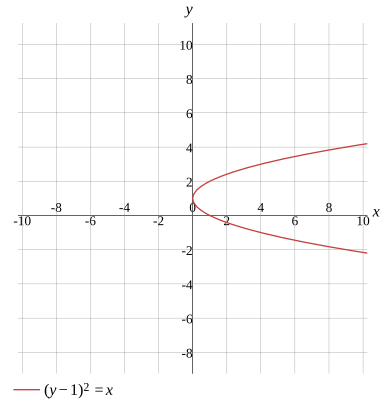Question
Identify the conic
Find the vertex of the parabola
Find the focus of the parabola
Find the directrix of the parabola
(0,1)
Rewrite in standard form
(y−1)2=x
Solution
(0,1)
Show Solution

Solve the equation
Solve for x
Solve for y
x=y2−2y+1
Evaluate
(y−1)2=x
Swap the sides of the equation
x=(y−1)2
Solution
x=y2−2y+1
Show Solution

Testing for symmetry
Testing for symmetry about the origin
Testing for symmetry about the x-axis
Testing for symmetry about the y-axis
Not symmetry with respect to the origin
Evaluate
(y−1)2=x
To test if the graph of (y−1)2=x is symmetry with respect to the origin,substitute -x for x and -y for y
(−y−1)2=−x
Evaluate
(y+1)2=−x
Solution
Not symmetry with respect to the origin
Show Solution

Find the first derivative
Find the derivative with respect to x
Find the derivative with respect to y
dxdy=2y−21
Calculate
(y−1)2=x
Take the derivative of both sides
dxd((y−1)2)=dxd(x)
Calculate the derivative
More Steps


Evaluate
dxd((y−1)2)
Evaluate the derivative
2(y−1)×dxd(y−1)
Evaluate the derivative
More Steps


Evaluate
dxd(y−1)
Use differentiation rules
dxd(y)+dxd(−1)
Evaluate the derivative
dxdy+dxd(−1)
Use dxd(c)=0 to find derivative
dxdy+0
Evaluate
dxdy
2(y−1)dxdy
Multiply the terms
(2y−2)dxdy
Multiply the terms
dxdy×(2y−2)
dxdy×(2y−2)=dxd(x)
Use dxdxn=nxn−1 to find derivative
dxdy×(2y−2)=1
Rewrite the expression
(2y−2)dxdy=1
Divide both sides
2y−2(2y−2)dxdy=2y−21
Solution
dxdy=2y−21
Show Solution

Find the second derivative
Find the second derivative with respect to x
Find the second derivative with respect to y
dx2d2y=−4y3−12y2+12y−41
Calculate
(y−1)2=x
Take the derivative of both sides
dxd((y−1)2)=dxd(x)
Calculate the derivative
More Steps


Evaluate
dxd((y−1)2)
Evaluate the derivative
2(y−1)×dxd(y−1)
Evaluate the derivative
More Steps


Evaluate
dxd(y−1)
Use differentiation rules
dxd(y)+dxd(−1)
Evaluate the derivative
dxdy+dxd(−1)
Use dxd(c)=0 to find derivative
dxdy+0
Evaluate
dxdy
2(y−1)dxdy
Multiply the terms
(2y−2)dxdy
Multiply the terms
dxdy×(2y−2)
dxdy×(2y−2)=dxd(x)
Use dxdxn=nxn−1 to find derivative
dxdy×(2y−2)=1
Rewrite the expression
(2y−2)dxdy=1
Divide both sides
2y−2(2y−2)dxdy=2y−21
Divide the numbers
dxdy=2y−21
Take the derivative of both sides
dxd(dxdy)=dxd(2y−21)
Calculate the derivative
dx2d2y=dxd(2y−21)
Rewrite the expression in exponential form
dx2d2y=dxd((2y−2)−1)
Calculate the derivative
More Steps


Evaluate
dxd((2y−2)−1)
Evaluate the derivative
−(2y−2)−2×dxd(2y−2)
Evaluate the derivative
−(2y−2)−2×2dxdy
Calculate
−2dxdy×(2y−2)−2
dx2d2y=−2dxdy×(2y−2)−2
Rewrite the expression
dx2d2y=−(2y−2)22dxdy
Calculate
dx2d2y=−2(y−1)2dxdy
Use equation dxdy=2y−21 to substitute
dx2d2y=−2(y−1)22y−21
Solution
More Steps


Calculate
−2(y−1)22y−21
Divide the terms
More Steps


Evaluate
2(y−1)22y−21
Multiply by the reciprocal
2y−21×2(y−1)21
Multiply the terms
(2y−2)×2(y−1)21
Use the commutative property to reorder the terms
2(2y−2)(y−1)21
−2(2y−2)(y−1)21
Expand the expression
More Steps


Evaluate
2(2y−2)(y−1)2
Expand the expression
2(2y−2)(y2−2y+1)
Multiply the terms
(4y−4)(y2−2y+1)
Apply the distributive property
4y×y2−4y×2y+4y×1−4y2−(−4×2y)−4×1
Multiply the terms
4y3−4y×2y+4y×1−4y2−(−4×2y)−4×1
Multiply the terms
4y3−8y2+4y×1−4y2−(−4×2y)−4×1
Any expression multiplied by 1 remains the same
4y3−8y2+4y−4y2−(−4×2y)−4×1
Multiply the numbers
4y3−8y2+4y−4y2−(−8y)−4×1
Any expression multiplied by 1 remains the same
4y3−8y2+4y−4y2−(−8y)−4
If a negative sign or a subtraction symbol appears outside parentheses, remove the parentheses and change the sign of every term within the parentheses
4y3−8y2+4y−4y2+8y−4
Subtract the terms
4y3−12y2+4y+8y−4
Add the terms
4y3−12y2+12y−4
−4y3−12y2+12y−41
dx2d2y=−4y3−12y2+12y−41
Show Solution

Rewrite the equation
r=2sin2(θ)2sin(θ)+cos(θ)+2sin(2θ)+cos2(θ)r=2sin2(θ)2sin(θ)+cos(θ)−2sin(2θ)+cos2(θ)
Evaluate
(y−1)2=x
Move the expression to the left side
y2−2y+1−x=0
To convert the equation to polar coordinates,substitute x for rcos(θ) and y for rsin(θ)
(sin(θ)×r)2−2sin(θ)×r+1−cos(θ)×r=0
Factor the expression
sin2(θ)×r2+(−2sin(θ)−cos(θ))r+1=0
Solve using the quadratic formula
r=2sin2(θ)2sin(θ)+cos(θ)±(−2sin(θ)−cos(θ))2−4sin2(θ)×1
Simplify
r=2sin2(θ)2sin(θ)+cos(θ)±2sin(2θ)+cos2(θ)
Solution
r=2sin2(θ)2sin(θ)+cos(θ)+2sin(2θ)+cos2(θ)r=2sin2(θ)2sin(θ)+cos(θ)−2sin(2θ)+cos2(θ)
Show Solution

Graph
